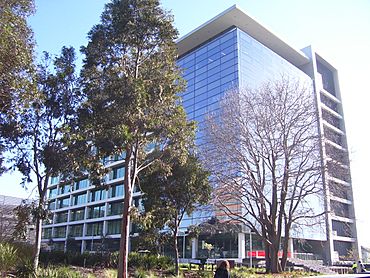Caulfield, Victoria facts for kids
Quick facts for kids CaulfieldMelbourne, Victoria |
|||||||||||||||
|---|---|---|---|---|---|---|---|---|---|---|---|---|---|---|---|

'H' building at Monash University's Caulfield Campus
|
|||||||||||||||
| Population | 5,748 (2021 census) | ||||||||||||||
| • Density | 3,830/km2 (9,900/sq mi) | ||||||||||||||
| Postcode(s) | 3162 | ||||||||||||||
| Elevation | 38 m (125 ft) | ||||||||||||||
| Area | 1.5 km2 (0.6 sq mi) | ||||||||||||||
| Location | 12 km (7 mi) from Melbourne | ||||||||||||||
| LGA(s) | City of Glen Eira | ||||||||||||||
| State electorate(s) | Caulfield | ||||||||||||||
| Federal Division(s) | Macnamara | ||||||||||||||
|
|||||||||||||||
Caulfield is a suburb in Melbourne, Victoria, Australia. It's about 10 kilometers (6 miles) south-east of Melbourne's city center. In 2021, about 5,748 people lived here. Caulfield is part of the City of Glen Eira local government area.
The suburb has clear borders. Kooyong Road is to the west, Glen Eira Road to the north, Glen Huntly Road to the south, and Booran Road to the east.
Caulfield is well-known for two main places. It is home to the famous Caulfield Racecourse. It also has a campus of Monash University.
Contents
History of Caulfield
What's in a Name?
No one is completely sure how Caulfield got its name. It might be linked to Baron Caulfield from Ireland. Perhaps an early settler named John Caulfield had something to do with it. The name "Caulfield" was already in use by 1853. Old maps always showed it near where the racecourse is today.
Before European Settlement
The local Yalukit people lived near the coast. They mostly ate seafood. Because of this, not many old Aboriginal items have been found in Caulfield. However, Aboriginal people and British settlers did meet in the area. Murrum Murrumbean was a local Aboriginal person. The nearby place name Murrumbeena comes from his name. Someone named Frederick Chapman once remembered a large corroboree (an Aboriginal gathering) in Hotham Street. Hundreds of Aboriginal people from Gippsland were there.
How Caulfield Started
In the mid-1800s, the Caulfield area was quite swampy. It was used by farmers to water their animals. They would drive their livestock from Gippsland to Melbourne through this area.
By the 1840s, a few small communities had grown. Owensville was near the west end of Glen Eira Road. Alma Road Village was another area further north. Camden Town was a working-class area. It was located where Glen Huntly and Hawthorn Roads meet.
The area south of Paddy's Swamp (now Caulfield Park) became the main shopping spot. The first church was called the Black Chapel. This building later became Boxill's general store. In 1857, the whole area was officially named the Caulfield Road District. Over the next few decades, many large homes for wealthy Melbourne citizens were built here. The Caulfield Post Office opened in 1863 but closed in 1974. The Caulfield Junction Post Office opened in 1923 and is still open today.
Who Lives in Caulfield?
| Historical population | ||
|---|---|---|
| Year | Pop. | ±% |
| 2001 | 4,857 | — |
| 2006 | 4,790 | −1.4% |
| 2011 | 5,160 | +7.7% |
| 2016 | 5,595 | +8.4% |
In 2016, about 5,595 people lived in Caulfield. Most people (53%) were born in Australia. Other common birthplaces included South Africa (5.4%), China (3.3%), and Israel (3.0%).
Most people (63.1%) spoke only English at home. Other languages spoken included Russian (6.0%), Hebrew (4.1%), and Greek (3.8%). When asked about religion, many people said Judaism (40.5%). Others chose No Religion (21.6%) or Catholic (10.5%).
Parks and Green Spaces
Caulfield Park is a large park near Caulfield. It covers about 26 hectares (64 acres). The park has a war memorial, a pretty lake, and fields for different sports. It is bordered by Hawthorn, Balaclava, and Inkerman Roads, and Park Crescent.
Getting Around Caulfield
Many main roads help people get around Caulfield. Roads going north and south include Kooyong Road, Hawthorn Road, and Booran Road. Roads going east and west include Glen Eira Road and Glen Huntly Road.
Trams
Two tram lines run through Caulfield:
- Route 64: This tram goes from Melbourne University to Brighton East. It travels along Hawthorn Road.
- Route 67: This tram goes from Melbourne University to Carnegie. It travels along Glen Huntly Road.
Buses
Three bus routes serve the suburb:
- 605: From Flagstaff station to Gardenvale. It uses Kooyong Road.
- 623: From Glen Waverley station to St Kilda. It travels along Neerim Road, Booran Road, and Glen Eira Road.
- 624: From Kew to Oakleigh station. It travels along Booran Road.
Trains
No train lines go directly through Caulfield. However, there are stations in nearby suburbs. These stations are on the Cranbourne, Frankston, Pakenham, and Sandringham lines.
Nearby train stations include:
- Caulfield station: This station is in Caulfield East. It serves the Cranbourne, Frankston, and Pakenham lines.
- Elsternwick station: This station is in Elsternwick. It is on the Sandringham line.
- Glen Huntly station: This station is in Glen Huntly. It is on the Frankston line.
Sports in Caulfield
Caulfield has an Australian Rules football team. They play in the Southern Football League.
Famous People from Caulfield
Many well-known people have lived in Caulfield, including:
- Warwick Armstrong: A famous Australian cricket captain. He grew up near Caulfield Park.
- Deborah Conway: A talented musician.
- Clarrie Grimmett: Another Australian cricketer.
- Michael Gudinski: A very important music executive and promoter.
- Ella Hooper: The lead singer of the band Killing Heidi.
- Graham Kennedy: A popular TV personality.
- Violet Mount: An operatic singer.
- Darby Munro: A famous jockey.
- Bill Ponsford: An Australian cricketer who moved to South Caulfield.



